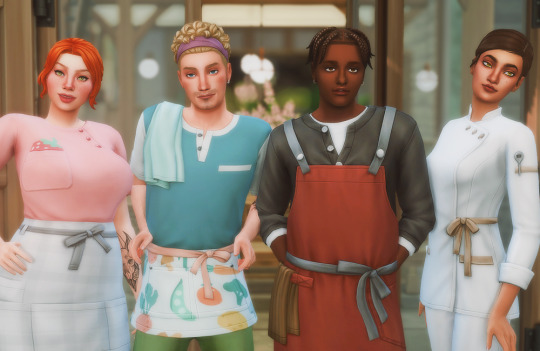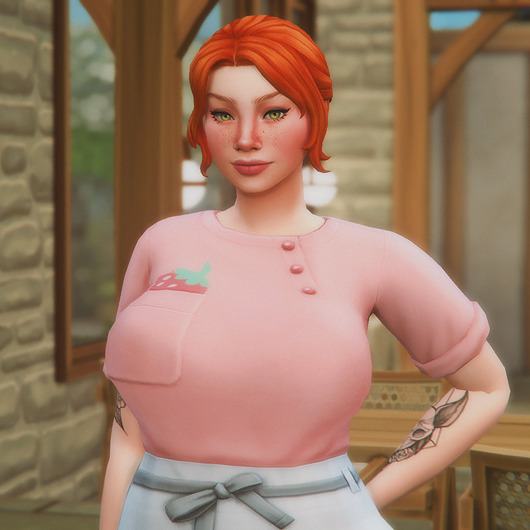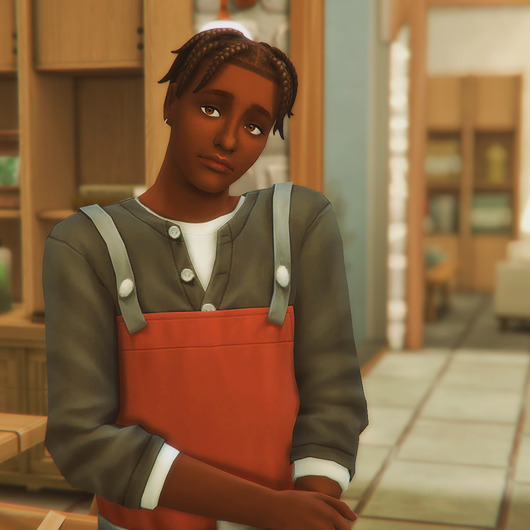#Green Hill is an obvious reference to Blue Hill at Stone Barns
Text





Meet this year's chefs-in-residence at Green Hill at Bagley Barns!
(from upper left to lower right):
Gina Wilson, a Henford on Bagley native will be our new junior saucier with a passion for local ingredients and the farm-to-table concept.
Magnus Broderson our new fermentation expert gained his previous experience at Nöma, Aurora Skies' most famous fine dining restaurant and we cannot wait to taste his signature lacto-ferments.
Michael Pollard, already a rising star in his hometown of Del Sol Valley will be filling in the position of junior sous chef for this year. Michael has an impressively long portfolio of top restaurants in which he worked and his creativity in recipe development is unrivaled.
Fatma Mohammadi our pastry chef from Al Simhara will enchant you with her sweet creations, as she did before in various restaurants and patisseriés all over the simglobe.
Next month's menu will be exclusively planned by our new chefs, so be sure to reserve a table on our website!
-> next
#sim: Gina Wilson#sim: Magnus Broderson#sim: Michael Pollard#sim: Fatma Mohammadi#ts4#the sims 4#sims 4#ts4 screenshots#ts4 simblr#ts4 edit#ts 4 story#sims 4 story#Green Hill is an obvious reference to Blue Hill at Stone Barns#I watched chefs table some time ago so...#I got this idea while I created a family for Jean and well her brother Michael was the perfect candidate for this#*mine#*mystory
19 notes
·
View notes
Photo

It’s not an obvious place to come across a piece of art. At an abandoned school, I climb a staircase past ivy-covered storage rooms to a raised outdoor space – and the swimming pool comes into scene-stealing view. The pool, faded starting blocks still in place, has not been used by schoolchildren for over a decade, yet it’s currently brimming with life. Hundreds of wooden boxes line its edges, each neatly packed with fresh flowers and plants, a sense of nurturing reflected in rainbow shades of pink, yellow and purple with hints of rosemary. But most eye-catching of all is the surface of the pool: smooth and glassy in hues of green, with seamless reflections of the forests, rice fields and skies that surround it, creating the sensation of stepping into a vast theatrical tableau of Japanese rural life.
One of Yayoi Kusama’s pumpkins on Naoshima
Forget the minimalist white walls of a modern art gallery in some cosmopolitan hub. This artwork – by Italian Giacomo Zaganelli – is situated somewhere entirely different: Shodoshima, a remote island surrounded by the calm waters of the Seto Inland Sea in Japan. It is just one of 213 artworks scattered across the rice fields, ports, old houses, beaches and vacant schools of 12 islands and two ports for this year’s Setouchi Triennale – the fourth edition since its 2010 launch. The concept, according to its founders, is simple: the event taps into the power of contemporary art to revitalise rural communities hit hard, like so many across Japan, by depopulation, tumbling birth rates and economic decline.
And it’s not just socially impactful – it’s also beautiful. The Seto Inland Sea, cocooned by three of Japan’s four main islands, is the perfect backdrop for art, a symphony of blues and whites – the beauty of the light is impossible to ignore – with the silhouettes of 3,000 small peaked islands hovering on the horizon.
A street on Shodoshima
Art was added to this alluring locale in more recent years: Naoshima – also known as the “art island” – led the way in the 1980s, when Soichiro Fukutake, a Japanese billionaire and philanthropist art collector, began transforming the island into a haven of contemporary art, fuelled by the belief that art is better appreciated in natural settings than in cities. Today, it’s home to a string of Tadao Ando-designed museums and outdoor installations by world-class artists, with Yayoi Kusama’s oversized pumpkins greeting visitors arriving at the port. The launch of the Setouchi Triennale in 2010 further spurred the spread of art across the entire region with increasingly tangible results: from an increase in visitors to a surge in its population.
“Rural art festivals involve artists confronting real problems in society”
I’m visiting the region ahead of the festival’s official opening, and I first stop on Shodoshima, an island that – reflecting the region’s reputation as the Mediterranean of Japan – is famous for its olives. After a short drive inland, I find the swimming pool artwork Fluire. Florentine artist Zaganelli pauses from putting the finishing touches to the flower-filled boxes, once used to store local noodles: “In winter, the landscape was yellow, but now it’s so green. Everything is continually changing, but this swimming pool is always here,” he says. “We don’t speak the same language, but locals immediately understood what we were doing. Everyone helped and tomorrow we will cook Italian food – risotto, tiramisu – for everyone to say thank you.”
Fluire on Shodoshima
Venturing deeper into Shodoshima, I stop in a peaceful green valley filled with tiered rice fields, fruit trees and birdsong – as well as a towering fairytale-style structure handmade from 4,000 pieces of bamboo. It’s by Taiwanese artist Wang Wen-Chih and is his fourth iteration, a new design rebuilt every three years ever since the festival began. Stepping over a tiny knee-high gate with a slightly pointless padlock, I wander along a narrow bamboo pathway that leads into a vast central space, sunlight filtering peacefully through the towering ceiling, before I hear a booming “No shoes!” Quickly slipping off my trainers, I see that the voice belongs to Heiji Iguchi, a tough-looking 69-year-old local, a retired engineer and the artwork’s unofficial gate master.
Softening as he talks about his friendship with the artist, he says, “None of us knew anything about art at first. We were so surprised. Everybody said, ‘What is art?’” Laughing at the memory while proudly looking around, he adds, “I still don’t know what art is. But now at least I understand how the artist makes this structure.”
Bamboo artwork by Wang Wen-Chih
A quick lunch follows at nearby café Komame Shokudo, which offers jaw-dropping views across the valley and smiling female staff in tenugui headscarves (one made from a Yayoi Kusama pumpkin fabric, hinting at the region’s artistic pedigree). After enjoying a meal of rice balls and cold sesame somen noodles, it’s time to head to Teshima, just a short hop away by boat.
Despite its diminutive dimensions – Teshima is about 10 times smaller than Shodoshima – the island has become a textbook example of how art, architecture and nature can combine to sublime effect. Upon my arrival, it’s clear that art has become a comfortable part of daily life, as the elderly lady running the local bike rental store demonstrates by chatting easily about “the Boltanski down the road” (in reference to Christian Boltanski’s Les Archives du Coeur installation in a wooden house on a nearby beach) and urges me not to miss visiting Teshima Art Museum. The latter may not be new, but is a timeless attraction. And so, after cycling up and down hills, I stop by to gaze at the clouds while lying down in the soft-edged white space that takes inspiration from a drop of water.
UMITOTA by Akira Minagawa and Shinichiro Ogata on Teshima
Not far from the museum, a new addition for the current festival run is UMITOTA – a small house renovated by two leading Japanese designers Akira Minagawa and Shinichiro Ogata. The home – open for day visits and overnight stays – is likely to become a haven for Japanese design lovers. It has a façade of thousands of sparkling abalone shells; a tunnel-like wooden corridor at the entrance, which perfectly frames sea views when I glance back over my shoulder; a minimalist living area with warm chartreuse yellow textiles and an abstract wooden light sculpture by Morison Kobayashi; and a bath of Teshima stone.
That evening, I stay at Usagi House – an Airbnb homestay run by Japanese artists Shin and Emi Hirai, who moved to the island with their 11-month-old baby in search of a simpler, more creative life after six years living in Berlin. After picking me up in his small white truck, Shin – friendly and enthusiastic and dressed in a striped jumpsuit and cap – first takes me to a barn-style space they have transformed into a theatre to showcase their unique video and music performance unit called Usaginingen.
Artist Sarah Westphal
Unfortunately, I’ve just missed a show (there are several every week), but Shin takes me around the space, filled with cloud-like sculptural clusters of clear straws fashioned into Finnish-style himmeli (ornament) by local children. At the front, Emi, a former graphic designer, sits on a visual machine called TA-CO – consisting of a self-adapted bicycle that projects her abstract visuals onto the screen as she pedals. Later, at their home, we tuck into a dinner of cumin-sprinkled homegrown vegetables, soups and rice. “There are about 800 people [on Teshima] and most are over 60,” Shin explains. “But people are very friendly – we feel free here.”
Shin’s words reflect a general creative shift in the region, as the success of the festival appears to be working its magic and enticing a growing number of similarly open-minded Japanese to the region. The event – which has three seasonal programmes spanning over 100 days – is steadily growing. The number of artworks has nearly trebled from 76 in the first year. Visitor figures are also booming: a million people visited the last event in 2016 – and this year, over 300,000 visited during the festival’s first 10 days alone.
Sea Gulls Parking Lot by Takahito Kimura on Megijima
The next morning I take to the sea again, catching two boats to get to Ogijima. It’s a tiny island where clusters of old Japanese houses cling to narrow, steep hillside paths. After savouring the play of light and shadows at artist Jaume Plensa’s structure at the port, I wander up a steep path to a small wooden building, the former post office. Stepping inside, I’m enveloped in a warm, orange glow, as close-up video footage of a swirling octopus covers the far wall of a retro-style room and is reflected into an interior pool of water just in front of me. Its creator, Belgium-based artist Sarah Westphal – dressed in black, clutching tape and paper – steps quietly into the dark space beside me. “It’s a kind of longing for the sea,” she says. “Life is so loud and fast. I hope people can have a quiet, meditative experience when they come here.”
Continuing further along, I spy a stylish café with double-height ceilings, pendant lights and homemade breads and coffees. Inside, I meet 34-year-old Kaisho Damonte in his cap and apron. Together with his wife, Yuko, he opened Damonte & Co last year. The couple earlier gave up their busy jobs in Tokyo and spent a year travelling the world on the lookout for the perfect place to live, before stumbling across Ogijima. “We visited during the art festival in 2016 and instantly fell in love,” smiles Kaisho. “We moved here a few months later.”
Kaisho and Yuko Damonte from Damonte & Co café
Preparing a croque monsieur with wild boar he hunted himself (there are apparently around 300 wild boars on Ogijima, easily outnumbering the 170 residents), he adds, “What we love most is the atmosphere and the nature. People are so open and friendly, which is unusual for rural Japan. The school has even reopened, and there are 10 to 15 young families living here now.”
From Ogijima, a 20-minute boat hop takes me to Megijima and the geography shifts to windswept beaches, stone walls and pine trees. The hours pass quickly as I wander past spinning seagulls by artist Takahito Kimura and explore a former guesthouse turned arts hub called Little Shops on the Island. There are puddle-shaped ping-pong tables, Leandro Erlich’s spinning washing machines and tatami rooms with portraits of residents holding wedding photos.
A statue on Megijima
Sipping tea nearby at the new Megino café and guesthouse, I meet another example of the region’s revival: its owner, 31-year-old Satomi Mekada, who worked in Kyoto guesthouses before discovering Megijima. “When I first came here, it felt like home,” Mekada says. She aims to plant 100 lacquer trees – used in Japanese lacquerware, known as urushi – to revive local craftsmanship. “And people are so grateful – they all say, ‘Thank you for moving here.’”
At the end of a long day – and on my sixth ferry in total – I catch up with Fram Kitagawa, the festival’s visionary founding general director. As our boat pulls out of Tamano City’s Uno Port, the ever-dapper, refreshingly direct and often chain-smoking Kitagawa, wearing a light-grey suit, sinks into a seat and expounds on the Setouchi Triennale’s ongoing theme of restoring the sea. “We want to restore the islands, give them more vitality, make them less isolated,” he says from beneath a jaunty wide-brimmed hat. “There are positive changes already: Shodoshima’s population is increasing and newcomers are moving to Ogijima.”
The event has not been without its challenges: the deeply complex logistical implications of creating artworks in remote, rural settings; the practicalities of creating a festival spanning a large number of islands and ports; and conveying the concept behind the festival to local elderly communities unused to contemporary art. According to Kitagawa, however, it’s worth it.
“Art in the past was all about being understood, it was philosophical or conceptual and was put in a white cube,” he adds. “But rural art festivals involve artists going into the real world and confronting real problems in society. Art appreciation takes time. It doesn’t matter if elderly communities understand or not – they are simply happy to see more visitors. These encounters make them happier and healthier. This is the power of art.”
Kitagawa pauses to point towards the coast, where a neon sign reading “In Progress” lights up a dusky pink sky, part of a new artwork by Mischa Kuball. It’s a perfect summary of a festival whose deep-rooted impact on the region, reflected in the rising populations, the reopened school and the engaged elderly communities, is perhaps the ultimate legacy of contemporary art. And it’s only just getting started.
SEE ALSO: 5 art-driven islands near Hiroshima worth exploring
This article was originally published in the June 2019 issue of SilverKris magazine
The post The Setouchi Triennale and the power of art and nature in Japan appeared first on SilverKris.
0 notes